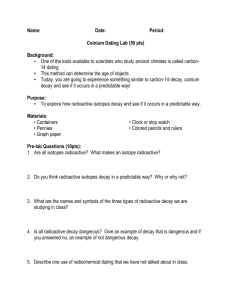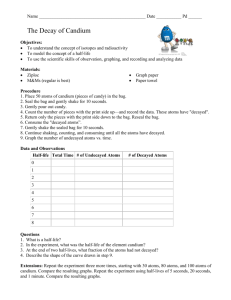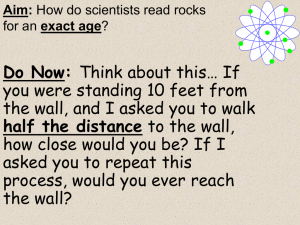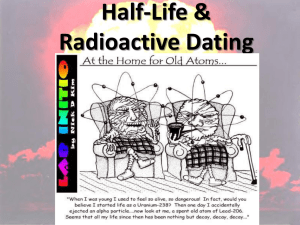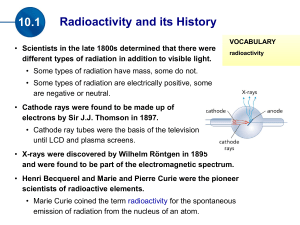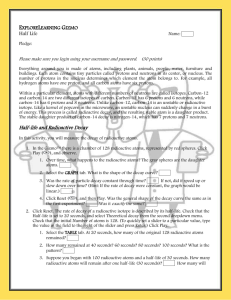Teacher notes and student sheets
advertisement
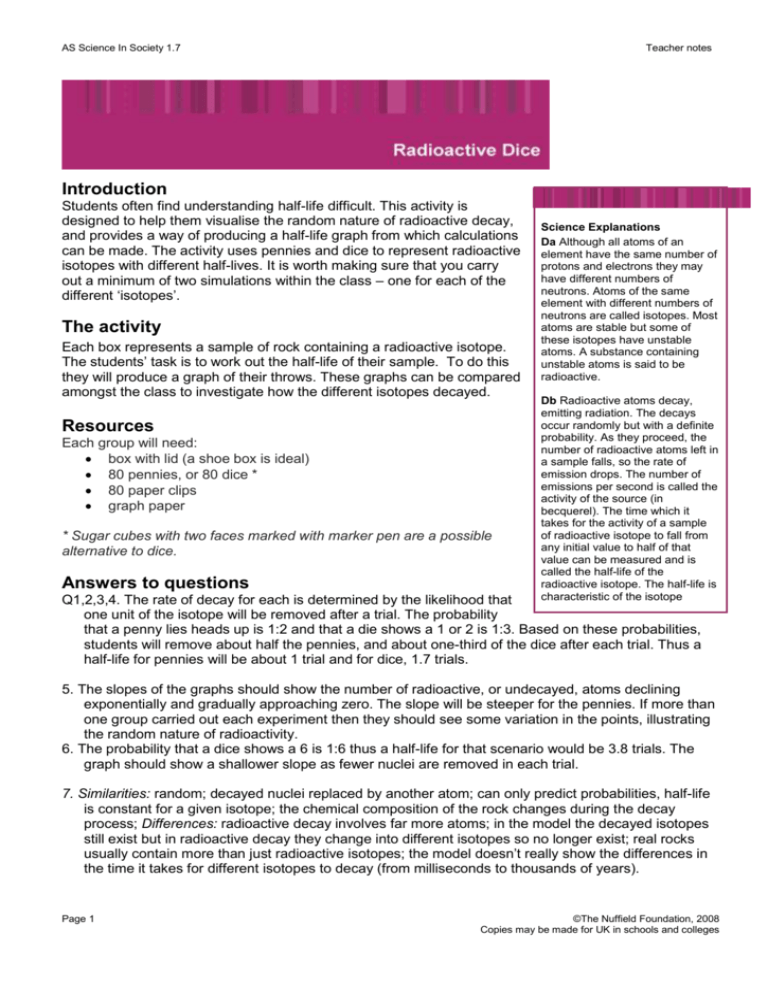
AS Science In Society 1.7 Teacher notes Introduction Students often find understanding half-life difficult. This activity is designed to help them visualise the random nature of radioactive decay, and provides a way of producing a half-life graph from which calculations can be made. The activity uses pennies and dice to represent radioactive isotopes with different half-lives. It is worth making sure that you carry out a minimum of two simulations within the class – one for each of the different ‘isotopes’. The activity Each box represents a sample of rock containing a radioactive isotope. The students’ task is to work out the half-life of their sample. To do this they will produce a graph of their throws. These graphs can be compared amongst the class to investigate how the different isotopes decayed. Resources Each group will need: box with lid (a shoe box is ideal) 80 pennies, or 80 dice * 80 paper clips graph paper * Sugar cubes with two faces marked with marker pen are a possible alternative to dice. Answers to questions Science Explanations Da Although all atoms of an element have the same number of protons and electrons they may have different numbers of neutrons. Atoms of the same element with different numbers of neutrons are called isotopes. Most atoms are stable but some of these isotopes have unstable atoms. A substance containing unstable atoms is said to be radioactive. Db Radioactive atoms decay, emitting radiation. The decays occur randomly but with a definite probability. As they proceed, the number of radioactive atoms left in a sample falls, so the rate of emission drops. The number of emissions per second is called the activity of the source (in becquerel). The time which it takes for the activity of a sample of radioactive isotope to fall from any initial value to half of that value can be measured and is called the half-life of the radioactive isotope. The half-life is characteristic of the isotope Q1,2,3,4. The rate of decay for each is determined by the likelihood that one unit of the isotope will be removed after a trial. The probability that a penny lies heads up is 1:2 and that a die shows a 1 or 2 is 1:3. Based on these probabilities, students will remove about half the pennies, and about one-third of the dice after each trial. Thus a half-life for pennies will be about 1 trial and for dice, 1.7 trials. 5. The slopes of the graphs should show the number of radioactive, or undecayed, atoms declining exponentially and gradually approaching zero. The slope will be steeper for the pennies. If more than one group carried out each experiment then they should see some variation in the points, illustrating the random nature of radioactivity. 6. The probability that a dice shows a 6 is 1:6 thus a half-life for that scenario would be 3.8 trials. The graph should show a shallower slope as fewer nuclei are removed in each trial. 7. Similarities: random; decayed nuclei replaced by another atom; can only predict probabilities, half-life is constant for a given isotope; the chemical composition of the rock changes during the decay process; Differences: radioactive decay involves far more atoms; in the model the decayed isotopes still exist but in radioactive decay they change into different isotopes so no longer exist; real rocks usually contain more than just radioactive isotopes; the model doesn’t really show the differences in the time it takes for different isotopes to decay (from milliseconds to thousands of years). Page 1 ©The Nuffield Foundation, 2008 Copies may be made for UK in schools and colleges AS Science In Society 1.7 Student sheets Introduction A radioactive isotope’s nucleus is unstable and spontaneously decays, giving off radiation and changing into a different isotope. Radioactive decay is a random event. We cannot say when an individual atom will decay. However, we can study large numbers of atoms and predict what proportion of them will decay in a given time. The rate at which nuclei decay is constant. Half-life describes the interval of time during which half of the original atoms decay. In this activity you will be given a sample of ‘radioactive rock’ which contains a ‘radioactive isotope’. Your task is to work out the half-life of your sample. The activity 1. Put the lid on your box and turn over twice. 2. Open the box and remove all the coins showing heads or a dice showing a 1 or a 2. These are the ‘decayed atoms’. Record the number on a chart like this one: Trial number Decayed atoms Undecayed atoms 3. Replace the ‘decayed atoms’ with paperclips. These represent the stable ‘daughter nuclei’ that the ‘radioactive atoms’ have changed into. 4. Record the number of ‘undecayed atoms’ that are left in your box. This completes the first trial. 5. Carry out further trials by repeating steps 1-4 until all your ‘atoms’ have decayed and you are left with only paperclips in your box. Questions: 1. How many trials does it take for half of the original 80 atoms to decay (be replaced by paper-clip daughter atoms)? 2. After half (or 40) of the atoms are replaced, how many trials does it take for half of the remaining atoms to decay? 3. Produce a graph to illustrate your isotope’s rate of decay. Plot the number of trials on the horizontal axis and the number of undecayed atoms on the vertical axis. 4. What is the half-life of your sample? Page 1 ©The Nuffield Foundation, 2008 Copies may be made for UK in schools and colleges AS Science In Society 1.7 Student sheets 5. Compare and discuss graphs for different isotopes. How are the curves similar and different? What do the curves suggest about the rate of radioactive decay in general? 6. How would the graph (and half life) differ if you had removed only dice with a 6 showing? 7. How is this model similar to radioactive decay? How is it different? August 2008 Page 2 ©The Nuffield Foundation, 2008 Copies may be made for UK in schools and colleges

